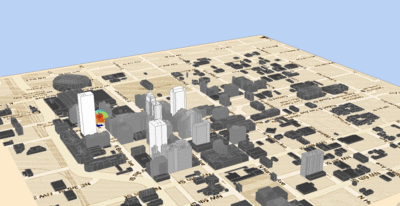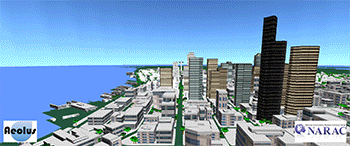LLNL/NARAC has developed the Aeolus model to accurately simulate high-resolution flow and dispersion of hazardous material in urban areas and complex terrain environments. The model has been used to develop emergency response planning guidance and is targeted for use in NARAC operational emergency response applications.
Aeolus is a full-physics building-resolving computational fluid dynamics (CFD) code based on the finite volume method. The model solves the time-dependent incompressible Navier-Stokes equations on a regular Cartesian staggered grid using a fractional step method. The model package includes a Lagrangian dispersion algorithm for predicting the transport and dispersion of neutral, buoyant and denser-then-air gases as well as particles. Aeolus can be run in either a fast operational mode based on a Reynolds Averaged Navier Stokes solver or in a more detailed mode using a Large Eddy Simulation (LES) method. Urban grids are rapidly generated from building footprint data stored in NARAC’s geographical databases.
Aeolus has been validated against experimental data taken from 12 Intensive Observation Periods of the Joint Urban 2003 field study conducted in Oklahoma City in July 2003. Very good agreement was obtained between Aeolus predictions and the concentrations of tracer gases measured at downwind sensors, with approximately 50% of the simulated results within a factor of two of the data. Notably, the Aeolus calculations for these comparisons ran in only six minutes on a desktop computer model, demonstrating that the model can meet the performance requirements for use in real-time operations.







